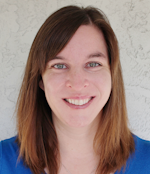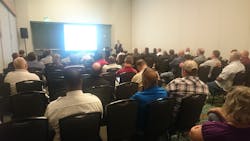Firehouse Expo offered special sessions Tuesday morning, including a joint session for the Community Risk Reduction (CRR) Workshop and the Chief-to-Chief Program. The sessions covered a variety of topics, including what CRR is (and is not), advocacy for fire sprinklers and fire safety, the state of the economy as it relates to fire protection issues, and promoting CRR through community paramedicine programs.
With the CRR Workshop being sponsored by the National Fire Sprinkler Association (NFSA), Shane Ray—president of the NFSA—opened the joint sessions with opening remarks about the future of the fire service, the impact of CRR and the role that chiefs will play in making a difference. Ray specifically addressed the increasing number of intelligent building systems, noting that the codes cycle is currently not able to keep up with these changing technologies. This means that there are lives at risk—people who don’t know their lives are at risk, including our own firefighters. He emphasized the need for the fire service to get involved in public policy, advocating for legislation that would keep codes up to date and create improved fire protection and fire safety.
Turning Tragedy into Advocacy
To underscore the importance of CRR, the first session focused on why it really matters—saving lives. Sher Grogg, a fire safety advocate for Common Voices, shared her story of tragedy and how that spurred her to action.
On Jan. 19, 2015, an electrical fire that spread to a 15-foot Christmas tree ignited a blaze that reduced a 16,000-square-foot, unsprinklered, riverfront mansion in Maryland to ruins, killing Grogg’s brother and sister-in-law, along with her four nieces and nephews. Since this tragic event, Grogg has become an advocate for residential fire sprinklers and is on a mission to help the fire service change legislation around the nation and drive home the importance of fire prevention.
Grogg emphasized that the general public—which included her before tragedy struck her family—doesn’t understand how fast fire is or even how fire sprinklers work. “No one thinks it will affect them,” she said. “So many don’t realize how many people die in their homes from fire.”
In addition to spreading the word about the importance of fire sprinklers, Grogg’s current mission is spreading the word about Christmas tree safety. She shared a flyer with safety tips and encouraged all attendees to download the flyer, or make copies of the one she shared, and distribute among the Christmas tree lots in their communities. The flyers, which is available at the Common Voices website, fireadvocates.org, can even be personalized with the fire departments’ names as well.
Grogg added that one person can make a difference, and that she pledged to her brother on his grave that she would do everything possible to educate people about fire safety. For more information and to print a flyer, visit fireadvocates.org.
The State of the Economy and the Future of the American Fire Service
The economy can be the driving factor or the limiting factor of the services we provide. In this session, Troy Markel—president of VFIS—noted 10 key issues that will affect the future of the American fire service:
- Finance—Markel noted that the economy is declining, and it’s important that fire responders consider how the federal, state and local governments can address debt issues.
- Politics—The #1 duty of local government is public safety—and it takes finesse and hard work.
- Immigration—Markel noted that immigration does not equal assimilation, and first responders must consider how to respond to a changing cultural landscape.
- Aging population—The population is getting older, which will impact call types in many communities.
- Generation—Markel spoke to the differences among different generations, noting that Millenials, for example, have a changing expectations of careers.
- Climate change—Unpredictable weather scenarios will change how many departments respond to WUI incidents.
- Changing nature of work—Fire departments must prepare for more than just fire calls, focusing on the all-hazards nature of the job.
- Drug epidemic—Markel explained that there are many drug-related issues in the country, including a serious problem with heroin that can lead to community and family decay.
- Unfunded liabilities—There are many to consider, including healthcare, social security, pensions, EMS demand and reimbursement, Markel said.
- Technology—It’s important to consider the impact of our “wireless world” as it relates to ever-present cameras as well as drones and social media.
Markel concluded that fire departments must consider how each of these factors impact a fire department’s service to the community and how CRR may be able to make a difference.
CRR—What It Is and What It Is Not
In his session, Randy Bruegman—the fire chief for the Anaheim, CA, Fire Department—explained how the fire prevention programs of the past have brought us to where we are today, but that we need to go further to develop a truly integrated program that will make a difference in your communities. Specifically, he said, community-based integrated community risk management is the approach that innovative leaders are taking to not only reduce risk but also create community resiliency.
“Fire prevention is about preventing fires in homes and businesses, and CRR is just that—looking at community risk as a whole and doing multiple things through multiple ways we may have not considered before,” he said. “It’s a cultural shift.” He added that we’re going to be asking the suppression people to do something that they didn’t sign up for, so to speak. “This may be our biggest challenge to moving this forward,” he said.
A key to CRR, Bruegman said, is predictive analysis—studying calls to determine where the issues exist and examining patterns that could help departments better focus their resources. There are many factors that play into this—density, demographics and socioeconomics—as well as research that can assist in interpreting the results.
So where do you begin in the efforts to create a safer community? Bruegman laid out the following steps:
- Develop a plan
- Conduct a community analysis
- Develop partnerships in community
- Create a strategy to solve problems
- Implement the strategy in the community
- Evaluate the results
Bruegman said that the components that make up an integrated CRR program include emergency response, education, enforcement, engineering and economic factors.
There are certainly obstacles to creating this level of integration, Bruegman said, including the fire service culture and paradigm that needs to be shifted to one that is open to this model. Ways to overcome these obstacles include making it a part of your strategic plan, incorporating CRR into the department’s vocabulary, and changing job descriptions and even the names of your bureaus or divisions to reflect the focus, and incorporating it into new hire training so the expectation is clear. Lastly, Bruegman said it is important to make CRR part of your organizational DNA.
Promoting CRR Through Community Paramedicine Programs
In his session, Paul Bourgeois—fire chief for the Superstition, AZ, Fire & Medical—shared the details of the $12.5 million community paramedicine grant that he and his organization are facilitating in cooperation with several partner organizations. The three-year program is funded by the Centers for Medicare/Medicaid Services and is paving the way for sweeping changes in the nation’s health-care system.
Chief Bourgeois explained how this program is advancing the principles of CRR by linking a comprehensive community risk analysis with a coordinated deployment of medical and behavioral health resources.
The CRR Workshop is presented in partnership with the Tennessee Fire Safety Inspectors Association and Vision 20/20. The Chief-to-Chief Program is also presented in partnership with the Tennessee Fire Safety Inspectors Association.

Janelle Foskett
Janelle Foskett served as editorial director of Firehouse Magazine and Firehouse.com, overseeing the editorial operations for the print edition along with working closely with the Web team.






